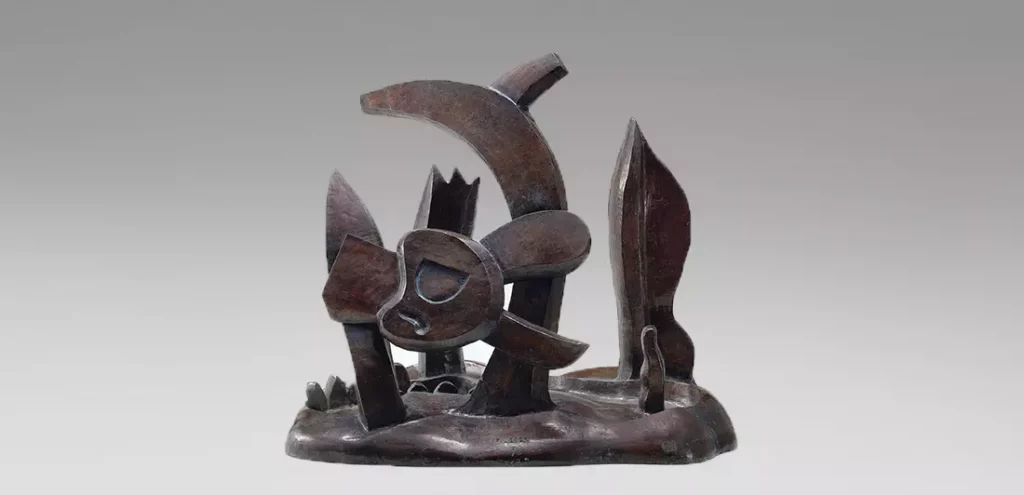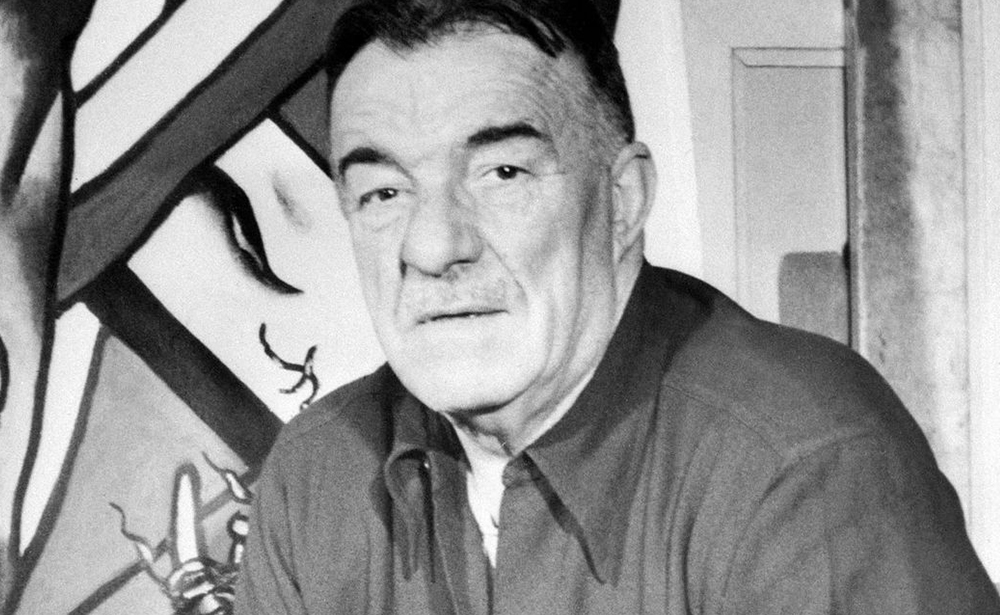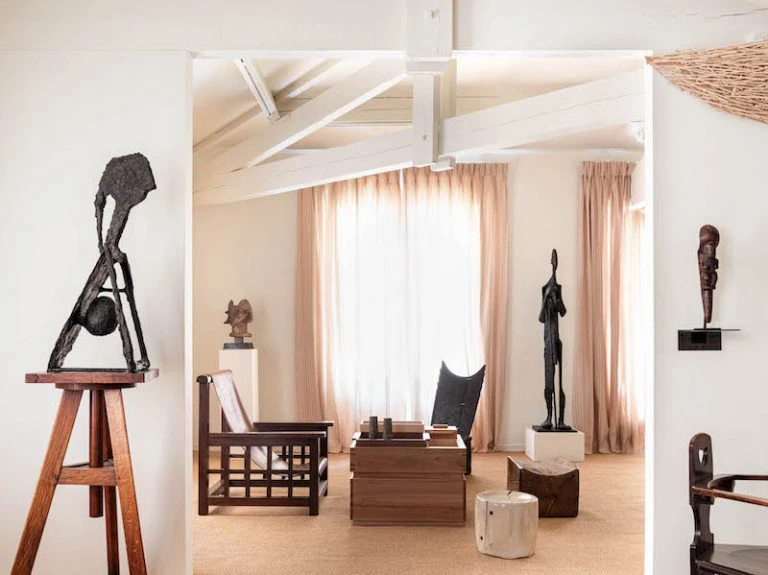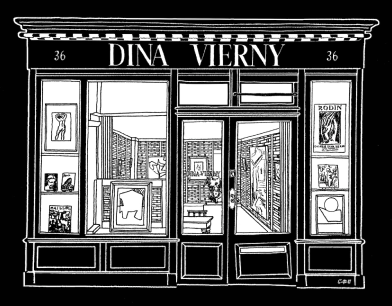

Fernand Léger was born in 1881 in the Orne region of France into a family of farmers. At the age of 19, he began studying architecture and left Normandy to head for the capital. Caught up in the artistic emulation of Paris in 1900, he abandoned his training as an architect and took up painting. He was influenced by the work of Cézanne in 1907 and discovered the cubism of Braque and Picasso. He moved to La Ruche the following year and met many artists such as Chaïm Soutine, Robert…
Fernand Léger was born in 1881 in the Orne region of France into a family of farmers. At the age of 19, he began studying architecture and left Normandy to head for the capital. Caught up in the artistic emulation of Paris in 1900, he abandoned his training as an architect and took up painting. He was influenced by the work of Cézanne in 1907 and discovered the cubism of Braque and Picasso. He moved to La Ruche the following year and met many artists such as Chaïm Soutine, Robert Delaunay and Marc Chagall. The year 1910 marked the beginning of Léger’s cubist period, a personal interpretation that was different from the cubism of Picasso and Braque. He then began to exhibit at the Salon d’Automne et des Indépendant and joined the Section d’Or group. In 1913, the art dealer Daniel Henri Kahnweiler offered him an exclusive contract, but his departure for the war the following year marked an abrupt break in his career.
Once his mobilization ended, it was modernization and industrialization that interested Léger. A large number of collaborations in the 1920s allowed him to broaden his creative fields, going for example to architecture and literature. He also directed the first film without a script, Le Ballet mécanique. In the 1930s Léger gained international recognition and exhibited in Europe and the United States. In 1937, he participated in the International Exhibition of Arts and Techniques. At the beginning of the Second World War, he went into exile in New York and worked and taught in the United States until he returned to France at the end of the conflict.
In 1949, Léger began practicing ceramics in Biot in the studio of Roland Brice, one of his former students. After creating bas-reliefs, the artist began to produce sculptures, of which La Fleur qui marche was one of the first to be conceived. Ceramic, a resistant material, lends itself perfectly to Léger’s aspirations to introduce color into landscapes. He adorns his works with bright colors because “Color is a vital necessity. It is a material essential to life like air and fire. For several years, he made numerous trips back and forth between the Paris region and the Brice workshop to work on his polychrome ceramic sculptures. At the same time, he started monumental projects for public buildings or places of worship. The artist died in 1955 in Gif-sur-Yvette. Five years later, a museum was dedicated to him in Biot.

Fernand Léger, la vie à bras-le-corps, Museum Soulages, Rodez (June 6 – November 6)
Fernand Léger. Le Beau est partout, Centre Pompidou-Metz, Metz (May 20 – October 30) ; Bozart, Bruxelles (February 9, 2018 – June 3, 2018)
Fernand Léger – Malerei im Raum, Museum Ludwig, Cologne (April 9 – July 3)
Fernand Léger, Galerie Malingue, Paris (February 21– April 30)
Fernand Léger. Paris – New York, Fondation Beyeler, Basel
Léger monumental, Les Abattoirs, Toulouse
Fernand Léger, Musée des Beaux-Arts, Lyon (July 1 – September 20)
Fernand Léger et les arts décoratifs, Biot, Musée national Fernand Léger
Fernand Léger : « de la couleur, de la couleur et des couleurs… », Belfort, Museum of Art and History
Léger : la céramique, Musée national Fernand Léger, Biot
Fernand Léger, The Museum of Modern Art, New York (February 15- may 12, 1998)
Rétrospective Fernand Léger, Paris, Centre Pompidou
Fernand Léger, Musée d’Art Moderne de Villeneuve d’Ascq, Villeneuve d’Ascq (March 3- June 17)
Léger et l’esprit moderne 1918-31, Musée d’Art Moderne de la Ville de Paris, Paris (March 17 – June 6) ; Museum of Fine Arts, Houston ; Rath, Geneva
Hommage à Fernand Léger (1881-1955), Staatliche Kunsthalle, Berlin (October 24 – January 7, 1981) ; Musée Fernand Léger, Biot (May 29, 1981 – September 28, 1981)
Rétrospective Léger, Galeries Nationales du Grand Palais, Paris (October – January 1972)
Fernand Léger, Musée des Arts Décoratifs, Paris (June – October)
Fernand Léger, exposition rétrospective 1905-1949, Musée national d’art moderne, Paris (October 6 – November 13)
Fernand Léger, Kunsthaus Zürich, Zürich (April 30– May 25)
Charlotte Perriand : Fernand Léger, une connivence, Réunion des musées nationaux, Paris
Armory Show, New York
Fernand Léger was born in 1881 in the Orne region of France into a family of farmers. At the age of 19, he began studying architecture and left Normandy to head for the capital. Caught up in the artistic emulation of Paris in 1900, he abandoned his training as an architect and took up painting. He was influenced by the work of Cézanne in 1907 and discovered the cubism of Braque and Picasso. He moved to La Ruche the following year and met many artists such as Chaïm Soutine, Robert Delaunay and Marc Chagall. The year 1910 marked the beginning of Léger’s cubist period, a personal interpretation that was different from the cubism of Picasso and Braque. He then began to exhibit at the Salon d’Automne et des Indépendant and joined the Section d’Or group. In 1913, the art dealer Daniel Henri Kahnweiler offered him an exclusive contract, but his departure for the war the following year marked an abrupt break in his career.
Once his mobilization ended, it was modernization and industrialization that interested Léger. A large number of collaborations in the 1920s allowed him to broaden his creative fields, going for example to architecture and literature. He also directed the first film without a script, Le Ballet mécanique. In the 1930s Léger gained international recognition and exhibited in Europe and the United States. In 1937, he participated in the International Exhibition of Arts and Techniques. At the beginning of the Second World War, he went into exile in New York and worked and taught in the United States until he returned to France at the end of the conflict.
In 1949, Léger began practicing ceramics in Biot in the studio of Roland Brice, one of his former students. After creating bas-reliefs, the artist began to produce sculptures, of which La Fleur qui marche was one of the first to be conceived. Ceramic, a resistant material, lends itself perfectly to Léger’s aspirations to introduce color into landscapes. He adorns his works with bright colors because “Color is a vital necessity. It is a material essential to life like air and fire. For several years, he made numerous trips back and forth between the Paris region and the Brice workshop to work on his polychrome ceramic sculptures. At the same time, he started monumental projects for public buildings or places of worship. The artist died in 1955 in Gif-sur-Yvette. Five years later, a museum was dedicated to him in Biot.
Fernand Léger, la vie à bras-le-corps, Museum Soulages, Rodez (June 6 – November 6)
Fernand Léger. Le Beau est partout, Centre Pompidou-Metz, Metz (May 20 – October 30) ; Bozart, Bruxelles (February 9, 2018 – June 3, 2018)
Fernand Léger – Malerei im Raum, Museum Ludwig, Cologne (April 9 – July 3)
Fernand Léger, Galerie Malingue, Paris (February 21– April 30)
Fernand Léger. Paris – New York, Fondation Beyeler, Basel
Léger monumental, Les Abattoirs, Toulouse
Fernand Léger, Musée des Beaux-Arts, Lyon (July 1 – September 20)
Fernand Léger et les arts décoratifs, Biot, Musée national Fernand Léger
Fernand Léger : « de la couleur, de la couleur et des couleurs… », Belfort, Museum of Art and History
Léger : la céramique, Musée national Fernand Léger, Biot
Fernand Léger, The Museum of Modern Art, New York (February 15- may 12, 1998)
Rétrospective Fernand Léger, Paris, Centre Pompidou
Fernand Léger, Musée d’Art Moderne de Villeneuve d’Ascq, Villeneuve d’Ascq (March 3- June 17)
Léger et l’esprit moderne 1918-31, Musée d’Art Moderne de la Ville de Paris, Paris (March 17 – June 6) ; Museum of Fine Arts, Houston ; Rath, Geneva
Hommage à Fernand Léger (1881-1955), Staatliche Kunsthalle, Berlin (October 24 – January 7, 1981) ; Musée Fernand Léger, Biot (May 29, 1981 – September 28, 1981)
Rétrospective Léger, Galeries Nationales du Grand Palais, Paris (October – January 1972)
Fernand Léger, Musée des Arts Décoratifs, Paris (June – October)
Fernand Léger, exposition rétrospective 1905-1949, Musée national d’art moderne, Paris (October 6 – November 13)
Fernand Léger, Kunsthaus Zürich, Zürich (April 30– May 25)
Charlotte Perriand : Fernand Léger, une connivence, Réunion des musées nationaux, Paris
Armory Show, New York

Fernand Léger was born in 1881 in the Orne region of France into a family of farmers. At the age of 19, he began studying architecture and left Normandy to head for the capital. Caught up in the artistic emulation of Paris in 1900, he abandoned his training as an architect and took up painting. He was influenced by the work of Cézanne in 1907 and discovered the cubism of Braque and Picasso. He moved to La Ruche the following year and met many artists such as Chaïm Soutine, Robert…
Fernand Léger was born in 1881 in the Orne region of France into a family of farmers. At the age of 19, he began studying architecture and left Normandy to head for the capital. Caught up in the artistic emulation of Paris in 1900, he abandoned his training as an architect and took up painting. He was influenced by the work of Cézanne in 1907 and discovered the cubism of Braque and Picasso. He moved to La Ruche the following year and met many artists such as Chaïm Soutine, Robert Delaunay and Marc Chagall. The year 1910 marked the beginning of Léger’s cubist period, a personal interpretation that was different from the cubism of Picasso and Braque. He then began to exhibit at the Salon d’Automne et des Indépendant and joined the Section d’Or group. In 1913, the art dealer Daniel Henri Kahnweiler offered him an exclusive contract, but his departure for the war the following year marked an abrupt break in his career.
Once his mobilization ended, it was modernization and industrialization that interested Léger. A large number of collaborations in the 1920s allowed him to broaden his creative fields, going for example to architecture and literature. He also directed the first film without a script, Le Ballet mécanique. In the 1930s Léger gained international recognition and exhibited in Europe and the United States. In 1937, he participated in the International Exhibition of Arts and Techniques. At the beginning of the Second World War, he went into exile in New York and worked and taught in the United States until he returned to France at the end of the conflict.
In 1949, Léger began practicing ceramics in Biot in the studio of Roland Brice, one of his former students. After creating bas-reliefs, the artist began to produce sculptures, of which La Fleur qui marche was one of the first to be conceived. Ceramic, a resistant material, lends itself perfectly to Léger’s aspirations to introduce color into landscapes. He adorns his works with bright colors because “Color is a vital necessity. It is a material essential to life like air and fire. For several years, he made numerous trips back and forth between the Paris region and the Brice workshop to work on his polychrome ceramic sculptures. At the same time, he started monumental projects for public buildings or places of worship. The artist died in 1955 in Gif-sur-Yvette. Five years later, a museum was dedicated to him in Biot.

Fernand Léger, la vie à bras-le-corps, Museum Soulages, Rodez (June 6 – November 6)
Fernand Léger. Le Beau est partout, Centre Pompidou-Metz, Metz (May 20 – October 30) ; Bozart, Bruxelles (February 9, 2018 – June 3, 2018)
Fernand Léger – Malerei im Raum, Museum Ludwig, Cologne (April 9 – July 3)
Fernand Léger, Galerie Malingue, Paris (February 21– April 30)
Fernand Léger. Paris – New York, Fondation Beyeler, Basel
Léger monumental, Les Abattoirs, Toulouse
Fernand Léger, Musée des Beaux-Arts, Lyon (July 1 – September 20)
Fernand Léger et les arts décoratifs, Biot, Musée national Fernand Léger
Fernand Léger : « de la couleur, de la couleur et des couleurs… », Belfort, Museum of Art and History
Léger : la céramique, Musée national Fernand Léger, Biot
Fernand Léger, The Museum of Modern Art, New York (February 15- may 12, 1998)
Rétrospective Fernand Léger, Paris, Centre Pompidou
Fernand Léger, Musée d’Art Moderne de Villeneuve d’Ascq, Villeneuve d’Ascq (March 3- June 17)
Léger et l’esprit moderne 1918-31, Musée d’Art Moderne de la Ville de Paris, Paris (March 17 – June 6) ; Museum of Fine Arts, Houston ; Rath, Geneva
Hommage à Fernand Léger (1881-1955), Staatliche Kunsthalle, Berlin (October 24 – January 7, 1981) ; Musée Fernand Léger, Biot (May 29, 1981 – September 28, 1981)
Rétrospective Léger, Galeries Nationales du Grand Palais, Paris (October – January 1972)
Fernand Léger, Musée des Arts Décoratifs, Paris (June – October)
Fernand Léger, exposition rétrospective 1905-1949, Musée national d’art moderne, Paris (October 6 – November 13)
Fernand Léger, Kunsthaus Zürich, Zürich (April 30– May 25)
Charlotte Perriand : Fernand Léger, une connivence, Réunion des musées nationaux, Paris
Armory Show, New York
Galerie Dina Vierny
36 rue Jacob 75006 Paris
Open from Tuesday to Saturday from 10 a.m. to 7 p.m.
Galerie Dina Vierny
36 rue Jacob 75006 Paris
Open from Tuesday to Saturday from 10 a.m. to 7 p.m.
